Streaming TV is the future (some would say – the present), and there’s no question about it at this point – in the UK, and around the world.
From Netflix, Prime Video and Disney+, to local services like Sky’s NOW and ITVX, streaming is here to stay. But if you want a good streaming experience, there’s one device you need to buy – a streamer.
While Smart TVs are getting better and better, standalone streaming devices are still quite popular, and for a good reason. They’re faster and easier to use in most cases, they support a vast library of apps, and you can even take them with you when you go on holiday (without having to login to your services on a hotel TV).
Plus, they’re easier and cheaper to replace than a TV – when your Smart TV gets older, certain streaming apps may stop working. This doesn’t happen as often on streaming sticks – even older ones – but even if they do get obsolete at some point, you don’t have to buy a whole new TV.
So if you’re looking to replace your expensive Sky/EE/Virgin Media pay-TV subscription and become a ‘cord cutter’ – a good streaming device is almost essential these days.
There are plenty of streaming sticks and boxes out there. But in this roundup, I’ll take a closer look at three of the best in the UK market for 2025: Google’s “TV Streamer”, the Amazon Fire TV 4K Max (2nd Gen) Stick, and the Roku Streaming Stick 4K.
Among those three, Google is the only one that launched a new device in 2024 – the Google TV Streamer. The Fire TV Stick Max is from 2023, and the Roku Streaming Stick 4K goes all the way back to 2021.
They’re all excellent devices – but the Fire TV Stick 4K Max is our ultimate winner this year. Yes, after several years with Roku on top, it feels like Roku is getting a bit behind (especially in the UK – more on that later), so, while the Fire TV’s interface is still not for everyone – the device is the best overall these days.
You might have also heard about Sky and Virgin Media’s streaming-based devices – both called “Stream” – so I’ll go into some detail about these two as well, later in the article, as well as look at the Apple TV streamer.
Best Streaming Devices UK 2025
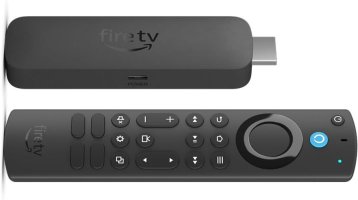
Amazon Fire TV Stick 4K MAX 2
BEST OVERALL
Speedy and powerful performance
Excellent 4K/HDR Quality
Almost all the major UK streaming services/apps
Live TV tab with UK broadcasters
Voice Remote with Alexa assistant
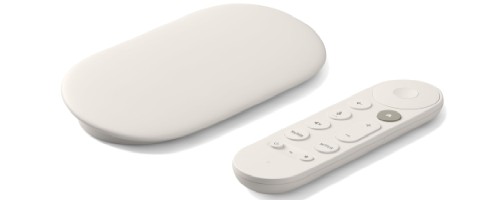
Google TV Streamer 4K
Most Flexible
Fast performance
Broad support for UK streaming services
Excellent 4K/HDR Picture Quality
The interface combines a mix of streaming services
Cast from phones
Table of Contents
Do I Need A Streaming Device?
A dedicated streaming device has a lot of advantages – but if you already have some sort of streaming solution, do you really need another one?
If you bought a new TV in recent years, chances are it’s a “Smart” TV, with streaming apps already baked in.
However, even if you have a Smart TV that comes with its own set of streaming apps, it’s still often a good idea (at least for some) to buy a dedicated streaming device.
Most TV manufacturers have their own “Smart” streaming interface – and those are often slow and confusing. Furthermore, some get abandoned pretty quickly – which means you might lose access to some of your favourite streaming services (or not get apps for newly launched services).
In 2022, for example, quite a few older Smart TVs – including from big manufacturers like Samsung – stopped supporting ITV Hub (or its replacement, ITVX) – and many customers were left without access to it.
The top streaming devices like the ones covered here, on the other hand, are quite the opposite – they’re fast (due to improved technical specs), very easy to use (as they’ve been around for years, perfecting their user interface), and they get constant updates and new apps (because so many people use them, so the streaming companies have the incentive to keep supporting them).
Another streaming device you might already have at home is a Freeview Play box – but while it’s true that those come with a few UK streaming apps (mostly the big UK public broadcasters like BBC iPlayer, Channel 4, etc. – with a few extras like YouTube and Prime Video, depending on the device), they’re no match for a ‘full’ streaming device that supports countless streaming services and apps.
And, as with older smart TVs – many older Freeview (and Freesat) boxes also didn’t get ITVX.
Another option that we’re seeing more and more, are Smart TVs that already have Roku or Amazon’s Fire TV operating system “baked” into them – so you get the popular, streamlined interface of one of those two, without having to buy another device.
However, many of these models are mid-range TVs, where the OS will still often feel somewhat sluggish.
So while it’s OK to start with a Smart TV – if you’re serious about streaming TV, it’s probably a good idea to upgrade to a dedicated streamer at some point.
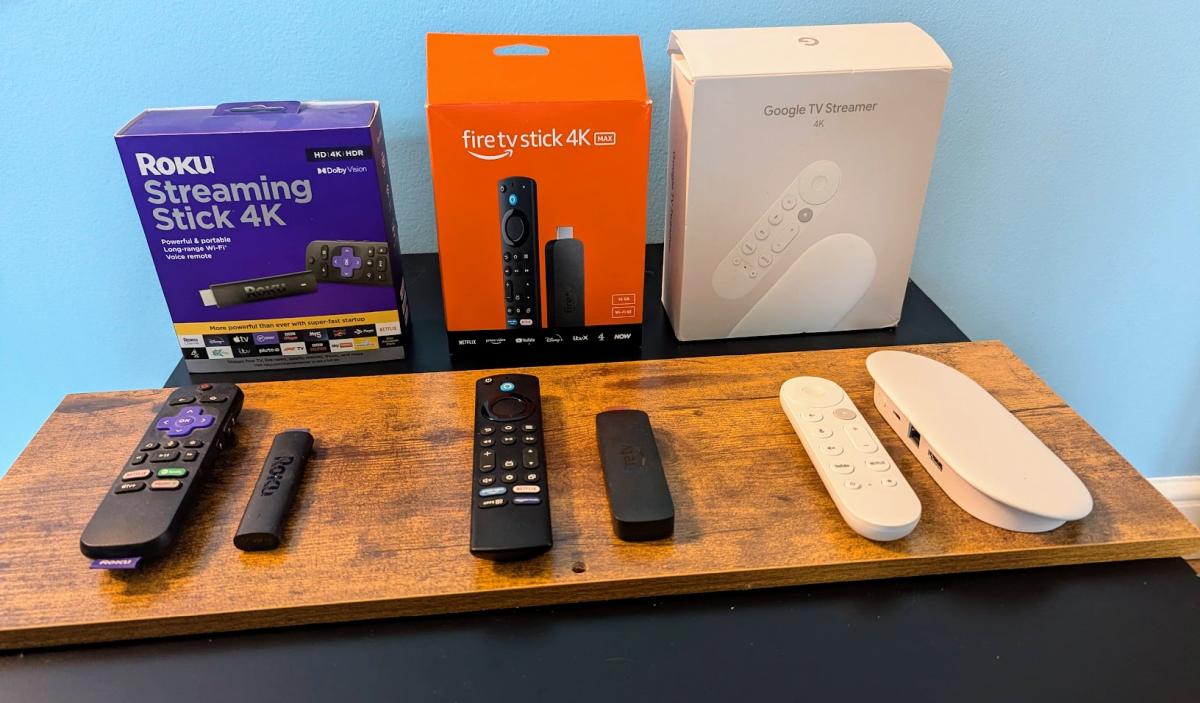
The Three Best Streaming Devices In The UK
There are a lot of streaming devices out there – but for this roundup, I’ve narrowed the list down to three, that represent the best combination of excellent performance, an easy to use interface and a budget-friendly price.
Those devices are The Roku 4K Streaming Stick 4K (see our full review), the Amazon Fire TV Stick 4K Max 2nd Gen (see our full review), and the new(ish) Google TV Streamer.
The Roku 4K was released late in 2021, to replace the previous model – the Roku Streaming Stick+. The Fire TV 4K Max 2nd Gen was released in 2023 to replace the first Max stick.
These were not major upgrades – and there’s still no major reason to switch if you have the previous generation. But if you’re in the market for a brand new streaming stick – you might as well go with the latest versions – which is why they’re covered in this roundup.
Yes, there are cheaper streaming devices out there – and there are more expensive ones. Take Apple TV, for example – it’s an excellent device for Apple fans – but it’s just too expensive, in my opinion, while not offering significant extra value.
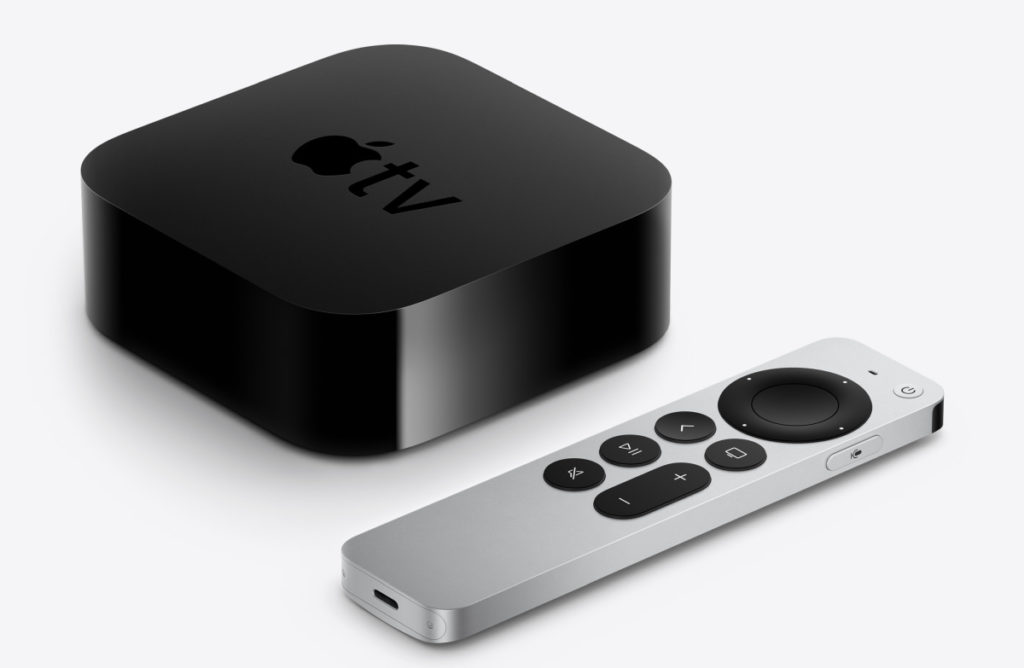
The Nvidia Shield TV is another similar example – a lot of people swear by it, and it’s also a very capable gaming console. But it’s too expensive if you just want to use it for streaming.
And on the low-cost side, there are lots of Chinese streaming sticks out there – they’re cheap, and they might work well, but they’re often a gamble – and their interface and user experience will never be as good as on the major streaming devices. Plus, they’re usually lacking in support for some of the primary streaming services.
Speaking of prices – the 2024 Google TV Streamer, which replaced the Google Chromecast with Google TV – almost doubled its price to £99 for no good reason. It reportedly has the same processor as the 4K Max, and while the hardware is slightly upgraded over the older Chromecast – it’s hard to understand why it needs to cost this much.
Unlike Google (which stopped selling older Chromecasts), Roku and Amazon also have cheaper entry-level versions of their streaming devices: The Roku Express (see our complete Roku comparison here), the Amazon Fire TV Stick HD (see our Fire TV specs comparison).
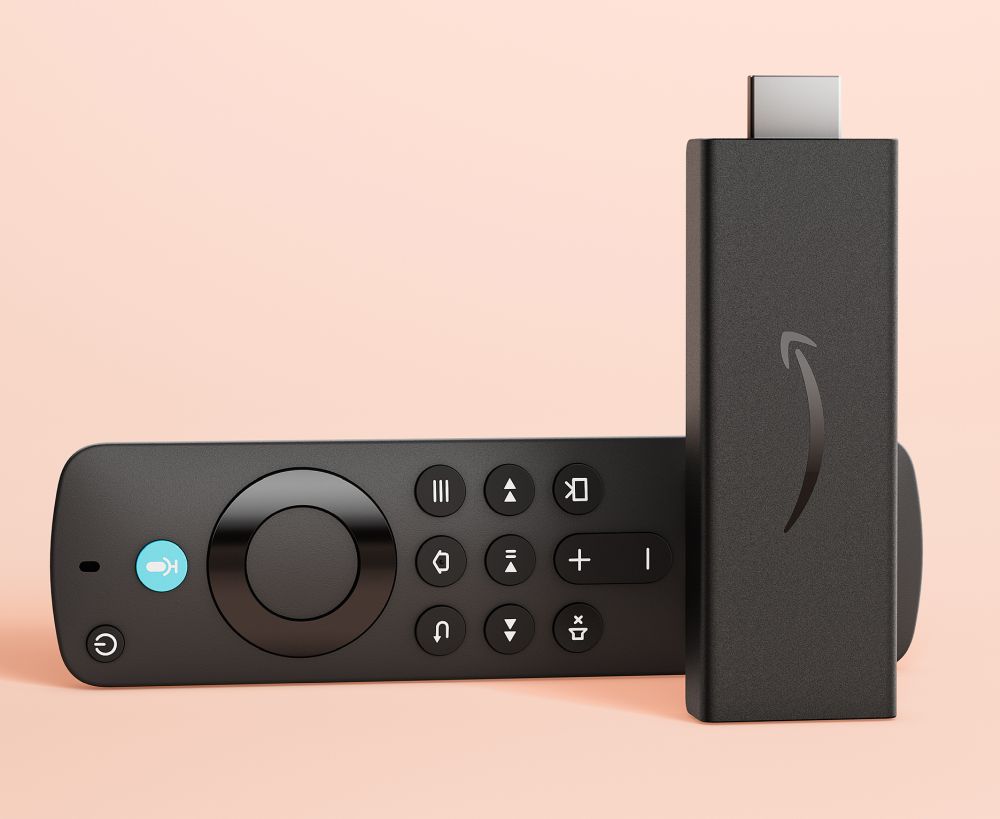
These low-cost versions are capable devices – though they don’t support 4K/HDR, and they’re somewhat underpowered, so the interface can feel slow at times.
That being said, if you’re making your first streaming steps and you just want a cheap solution – or you’re looking for an extra streaming device for the bedroom/guest room – these are decent solutions.
Roku Stick 4K, Firestick 4K Max And Google TV Streamer – The Similarities
Before I rank and compare the three devices, let’s quickly go over the things they have in common.
All three are HDMI-based streaming devices – so if you have an older TV with a SCART connection, for example, you’ll have to look elsewhere. (There are HDMI-to-SCART converters out there – but you’ll be downgrading the picture quality, and some services just won’t work).
If you’re running out of HDMI ports on your TV, you can always use an HDMI Switcher, and if you want to use one streamer with two (or more) TVs – you can use an HDMI Splitter.
All three devices connect to the internet via WiFi (The Roku stick has a built-in WiFi booster that increases the range).
The Fire TV 4K Max 2nd Gen supports the newer WiFi 6E standard, and also has an optional Ethernet adaptor if your WiFi reception is problematic.
The Google TV Streamer, somewhat embarrassingly, only support WiFi 5 – but at least its now box-shaped form factor includes a built-in Ethernet port.
As for power, all three are powered with a mini-USB plug, or a USB-C plug (Google TV Streamer), which you need to plug into the wall with the supplied USB mains adapter.
Roku Stick, Firestick And Google TV Streamer – The Differences
Now, let’s go over some of the important factors that differentiate the three devices – and see which one comes out on top.
Form Factor
The Roku Streaming Stick 4K and the Amazon Fire TV Stick 4K Max have a similar shape (the clue is in the name) of… a stick (similar to a USB stick).
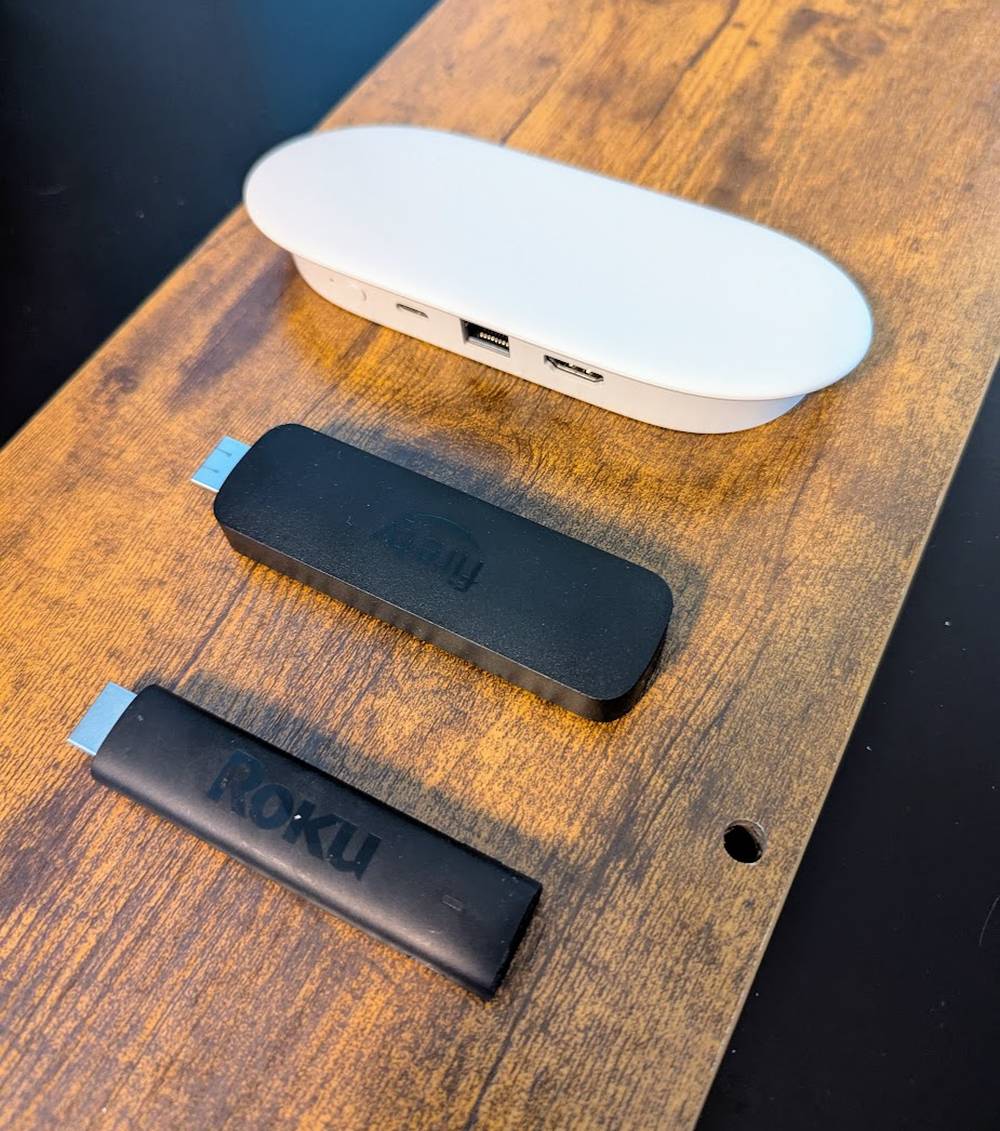
However, the Fire TV (108 x 30 x 14 mm) is bigger than the Roku Stick (94.5 x 21.1 x 11.5 mm). Because of its size, some might find it hard to find the space behind their TV to plug the Fire TV stick – and you might need to use an HDMI extension cable.
Fortunately, Amazon provides an HDMI extender in the box. Roku, on the other hand, does not. You can get one from them, for free – but you have to register and order it online.
Google’s older Chromecasts used to be shaped like small, round discs (with an HDMI cable attached) – but with the Google TV Streamer, the company opted to go for a set-top box, and you now get a small rounded box that you connect with an HDMI cable (which Google skimped on, so there’s no HDMI cable in the box).
So, in this category, mainly for being easy to carry and connect, the winners are…
Form Factor Winners: Fire TV Stick Max & Roku Streaming Stick 4K
Selection Of UK Streaming Apps
A streaming device is only as good as the actual streaming you can do on it – and for that, you need apps and support from the streaming services.
And in particular, you need UK-based support. Streamers that only support big US streaming services won’t help here – as we need things like BBC iPlayer, NOW, ITVX, etc. – and not just the big American ones like Netflix and Amazon’s Prime Video.
The Firestick, Google TV Streamer and Roku all support most of the major UK streaming services, so you’re going to do well with each of them.
However, there ARE a few minor differences – and if the particular streaming service you’re fond of is missing, that might be a dealbreaker.
So, for example, while the Google TV Streamer supports lots of apps via its “Chromecast” method (so you push content from your mobile phone to the TV), its selection of native Android TV apps is still somewhat limited, as some apps that used to work on the previous Chromecast, haven’t been updated yet – so they don’t work properly on the Streamer.
Also, when the Google TV Streamer launched in the UK, it didn’t even have a Channel 4 app (which was fixed after a few months), and it didn’t support BBC iPlayer – which took six months to fix. When a company launches a flagship streaming device in the UK without BBC iPlayer – it doesn’t bode well for its localisation plans.
Roku used to have an advantage in the apps arena thanks to their “Private / Non-certified” channels options, where you could install apps from outside the store by using a link and a code. These, however, were removed in 2022, as they presumably posed security and copyright risks.
A similar option does still exist on the Fire TV Stick and the Google TV Streamer, however – where people can “sideload” apps – that is, install “unofficial” apps and channels via APK files (but you have to be careful, as these too can present security risks if you’re not certain about their source).
The Roku does have one unique advantage with The Roku Channel – it’s a free (with adverts) streaming content channel that offers films, TV shows and Roku Originals – and it’s not available on the Fire TV or Google TV (but its content in the UK is quite limited, and full of shows and films you’ve never heard of).
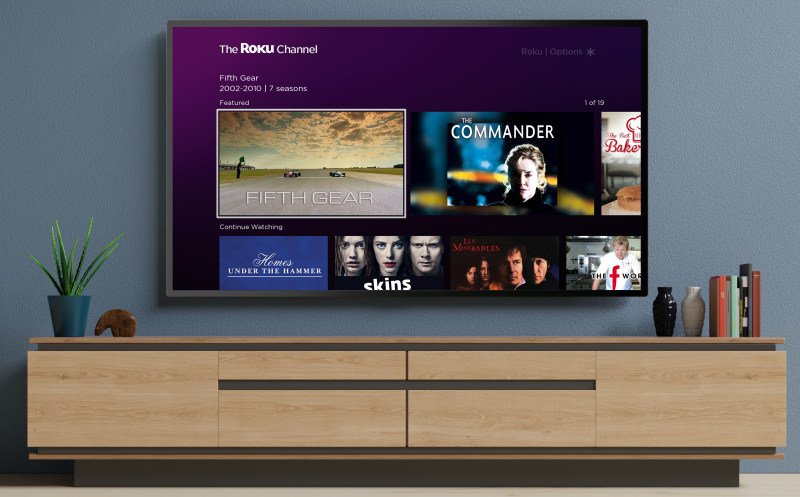
The bottom line is that the selection of streaming apps on all three devices is almost identical these days – with the Google TV Streamer falling a bit short due to it being newer.
So, with official apps, it’s almost a tie – but when looking at the sideloading options, and the Google TV Streamer still missing some app updates – we do have a winner (by points).
Selection Of UK Apps Winner: Amazon Fire TV 4K Max
Interface / Ease Of Use
One of the reasons people dislike Smart TVs is the user interface. It’s usually slow, unintuitive, and even confusing to some.
In fact, most Smart TVs probably won’t pass the Grandparents Test (as in – your grandparents come for a visit – can they operate your Smart TV by themselves?)
Things are very different with Roku and the Fire TV, however. Both devices offer friendly, easy-to-use interfaces that have been refined for several years, and yes – even your grandparents will probably understand what to do.
That being said, I feel the Roku takes the lead – at least in terms of how clean and easy to understand the interface is. Your apps (they’re called ‘Channels’ on Roku) take centre-stage, with big icons that stay in place (but you can re-order them any way you want).
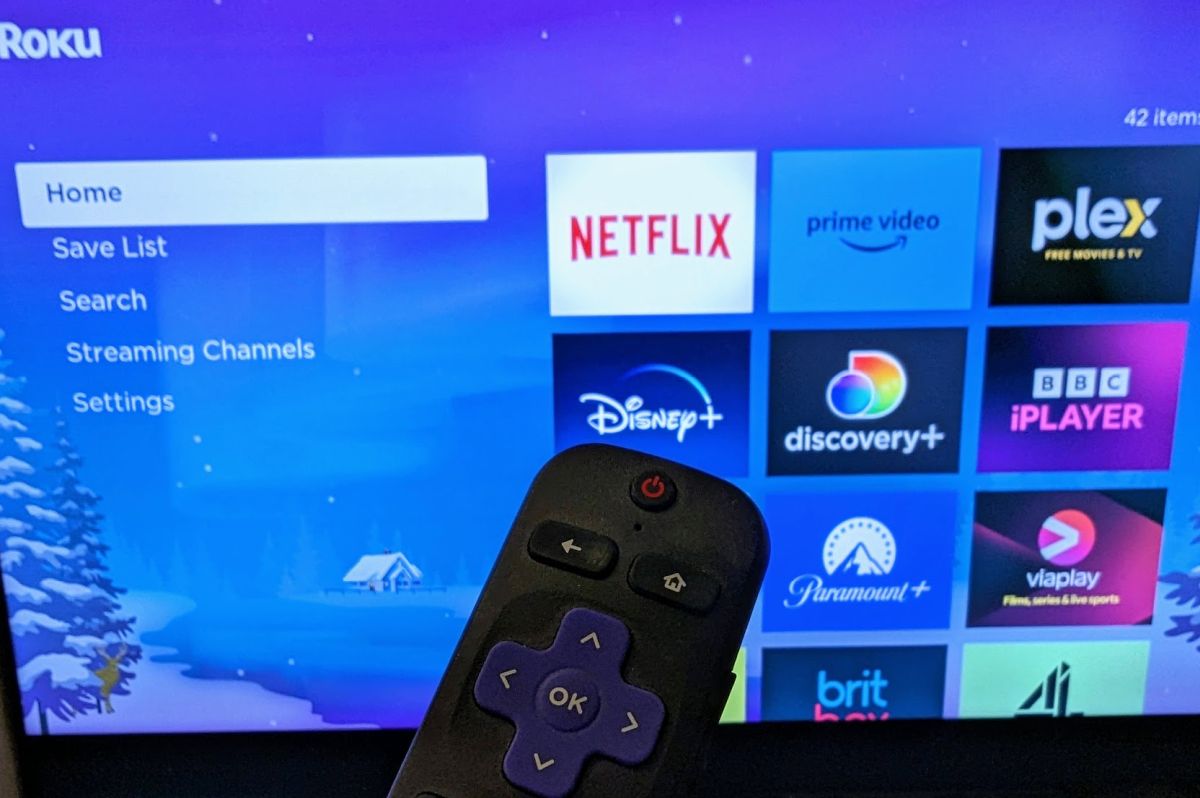
In 2023, Roku also made a big change with its operating system, adding a new “What To Watch” section that includes personalised recommendations and a global watchlist.

While it has a lot of potential, and it’s a welcome addition – I’m not sure that many Roku users are actually using that section – it feels a bit tacked on at this point.
Amazon’s Fire TV interface, while also slick and friendly, is a bit of a mess sometimes, with categories and apps moving around all by themselves. In addition, Amazon puts its own Prime Video content front and centre – which is fine if you’re a big Amazon fan (and if you’re subscribed to Prime), but otherwise can get annoying.
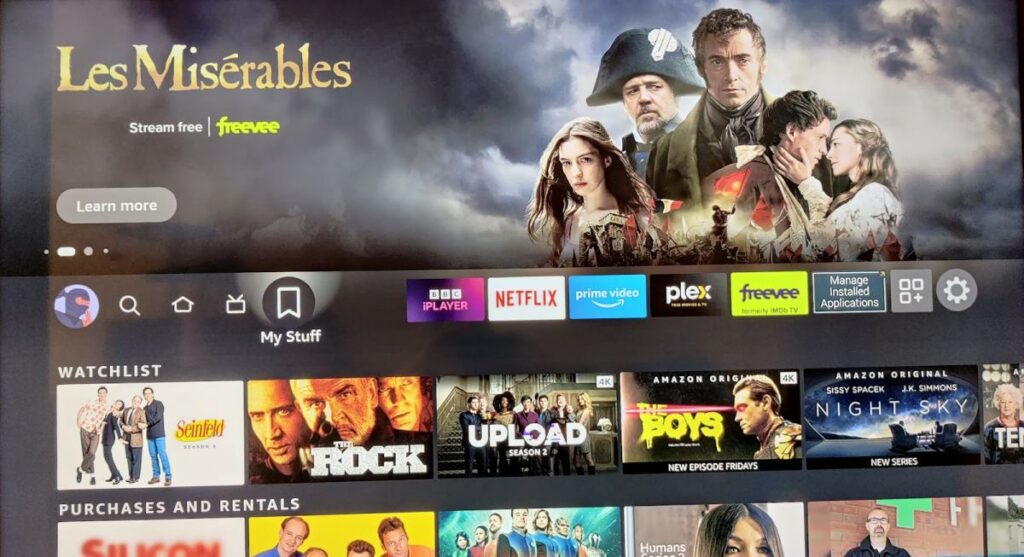
The Fire TV does have one significant upgrade – the Live TV tab. It’s a section that shows a TV guide (much like Freeview’s EPG), with the live schedule of all the big broadcasters – and the ability to jump to the connected app (BBC iPlayer, ITVX, Channel 4 and 5) when you want to watch a show that’s being aired (and streamed) right now.
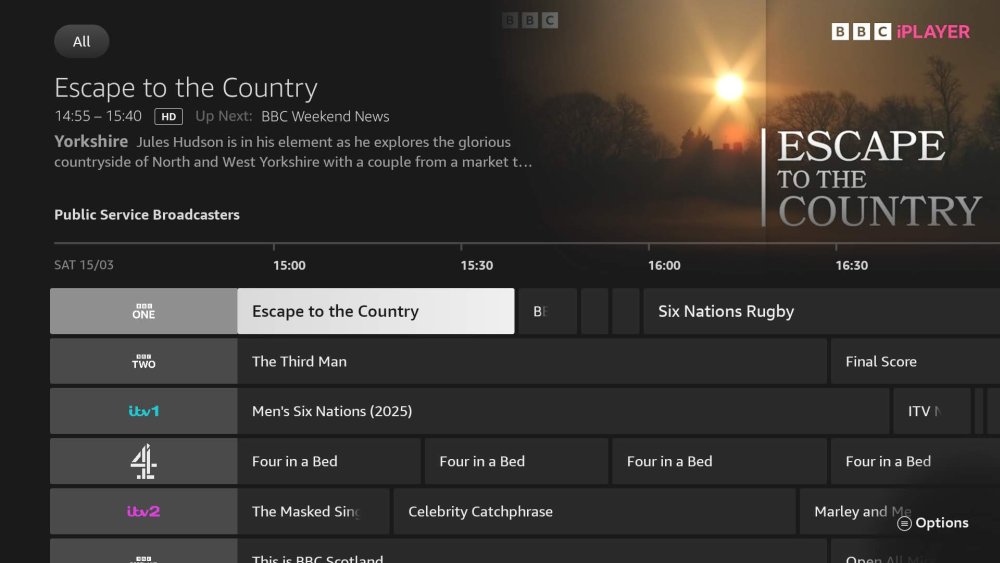
It was this year, when Amazon finally added the BBC to this live guide – which made it quite useful for those who still want to watch live TV. It’s certainly not as robust as the full Freeview EPG, or even the one on Freely (which streams shows natively, without having to open an app) – but it’s certainly a plus for some.
And the Google TV Streamer? The newer model’s interface is very similar to that of the older Chromecast with Google TV, with a few tweaks and changes.
It’s unique in that it combines content recommendations and a watchlist from several different streaming services – Netflix, Prime Video, Disney+ and others.
The Google TV Streamer holds a lot of promise, especially for those who use several different streaming services. However, even now, it’s still a bit rough around the edges, and it’s just as cluttered as the Fire TV Stick’s interface, without enough customisation options.
Picking a winner here is hard. If you’re a beginner, you want a very simple interface, or you just want the streaming stick to get out of the way as you tend to use each streaming service’s own interface – then the Roku is the clear winner.
But looking at the overall usability, customizability and options – the Fire TV is starting to jump ahead (with the Google TV Streamer close behind).
Interface Winner: Fire TV Stick 4K Max
Picture Quality
Although picture quality depends first and foremost on your TV, streaming devices also play an important part.
All three devices – The Roku Streaming Stick 4K, the Amazon Fire TV 4K Max Stick and the Google TV Streamer – support Ultra HD (4K) and HDR.
HDR stands for “High Dynamic Range” – it’s a technology that helps improve contrast rates, making the picture more accurate. It also provides a larger colour palette and more colour shades – and with a proper TV, it can make quite a difference in picture quality (but your streaming service needs to support HDR as well!).
To make things even more complicated, there are several competing HDR formats: HDR, HDR10+, HLG and Dolby Vision. The Roku Stick 4K model added Dolby Vision support – so now all three devices support all of these formats.
HDR10 is the popular format, and is supported by most major streaming services. But Dolby Vision is gaining some traction, and is considered superior – though, as always, your TV must support it as well.
Picture Quality Winner: 3-Way Tie
Performance
Performance is sometimes hard to measure on a streaming device – after all, every app and streaming service works differently, and it isn’t always the stick’s fault when something goes wrong.
And yes, compare any modern streaming device to an older Smart TV – and you’ll see the difference in speed right away.
So when I talk about Performance, I take into account the speed of the interface, how responsive the apps are, and how good the internet connection is (via WiFi).
This is another case where all three devices are pretty similar. They all have modern processors (Quad-Core), and the interface is fast to load and very responsive.
That being said – while the differences aren’t all that big – Roku’s 4K stick is beginning to feel a bit sluggish (with just 1GB of RAM). After all, it was released in 2021 – compared to the new 4K Max 2nd Gen which was released in 2023 (and has 2GB RAM), and the Google TV Streamer from 2024, which has 4GB of RAM.
They also differ in the amount of available storage (for installing apps, games, etc) – the Roku 4K Stick doesn’t even specify the exact amount, with the Fire TV 4K Max having 16GB, and the Google TV Streamer having 32GB.
Don’t get me wrong, the Roku still feels OK when you use it, especially compared to Smart TVs or older devices – but when you compare it directly to the Fire TV 4K Max, or even more so to the new Google TV Streamer, you start to feel the sluggishness.
As for WiFi, the Roku Stick 4K has a WiFi 5 amplifier built into its power cable – which gives you better range and a stronger signal. The Google TV Streamer also support WiFi 5.
The Fire TV 4K Max 2nd Gen, however, supports WiFi 6E – a more advanced technology that helps keep multiple WiFi connections (and devices) more stable.
But you need a WiFi 6E (or 6) router to take advantage of the extra features, and not all UK ISPs provide a WiFi 6 router.
Performance Winner: Google TV Streamer
Apps Variety (Not Just Streaming!)
While streaming services and apps are the ‘main event’ for a streaming device – they’re not the only thing you can do with it.
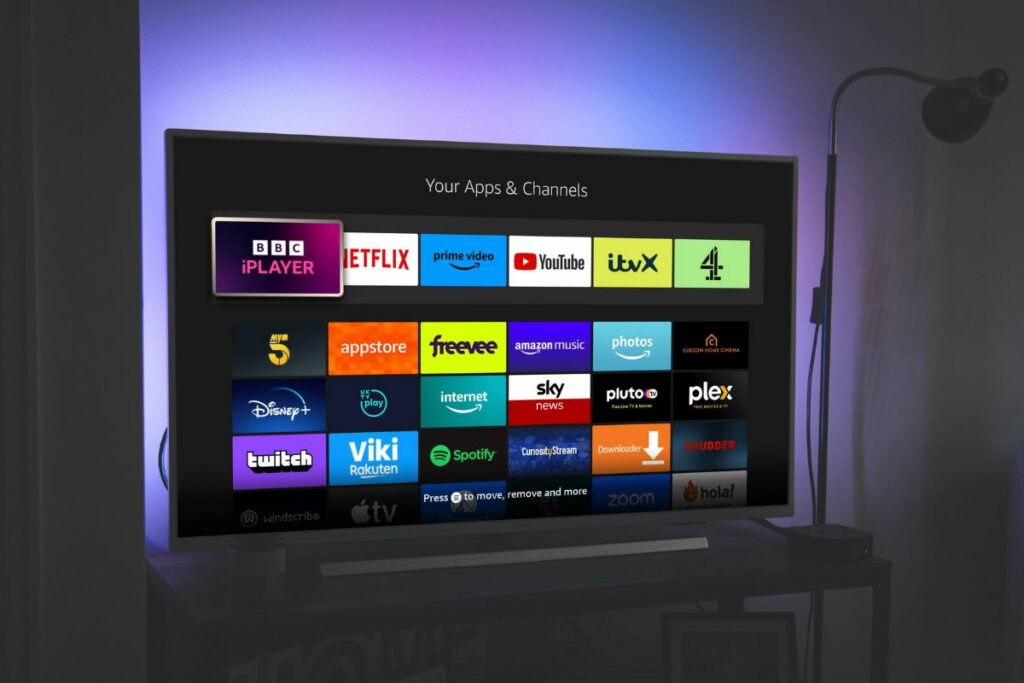
From watching music videos and lectures, to practising yoga and even playing games – modern streaming devices are tiny computers connected to your TV.
And while they’ll never replace a full-featured gaming console or a PC, the extra apps are still a factor when you consider which streaming device to get.
The Amazon Fire TV has its own app store, where it’s easy to find and download apps directly (here are some of the best apps for the Firestick). Roku also has a ‘Channels Marketplace’, where you go to search for ‘Channels’. (And here are our recommended Roku channels).
With the Google TV Streamer, you get two options – there’s an app store for native Google TV apps (which you can then control with the remote, with an on-screen interface).
And, there’s also the smartphone-supported version, where you “cast” content from apps on your phone to the streamer, like with the old Chromecast pucks.
The Amazon Fire TV and Google TV Streamer, however, take the lead by supporting two types of apps that aren’t supported on any Roku devices for now – VPN, and a browser.
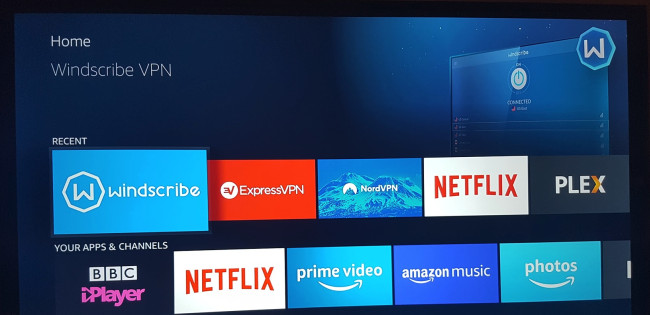
A VPN is helpful if you want to protect your privacy when you’re using a streamer, or to unblock Geo-Restrictions on Netflix and similar services. The Fire TV and Google TV Streamer have quite a few supported VPN apps, which is a big plus.
And, the Fire TV also has an internet browser – Amazon’s own ‘Silk’ browser (it used to also have Firefox, but that’s gone). While browsing the open web on your TV is never a very good experience, it does give you some extra flexibility.
The Google TV Streamer, on the other hand, is a mixed bag in this case – you can “cast” from a native Chrome browser on another device, but there’s no native version of Chrome for Google TV.
As for Roku’s channel store, it actually BANS browser apps – so you’re not going to see them anytime soon.
Selection of Apps Winner: Amazon Fire TV 4K Max
Remote Controls
Although we’re getting used to doing everything with our smartphones – when operating a TV, a remote control is still the easiest way to control things.
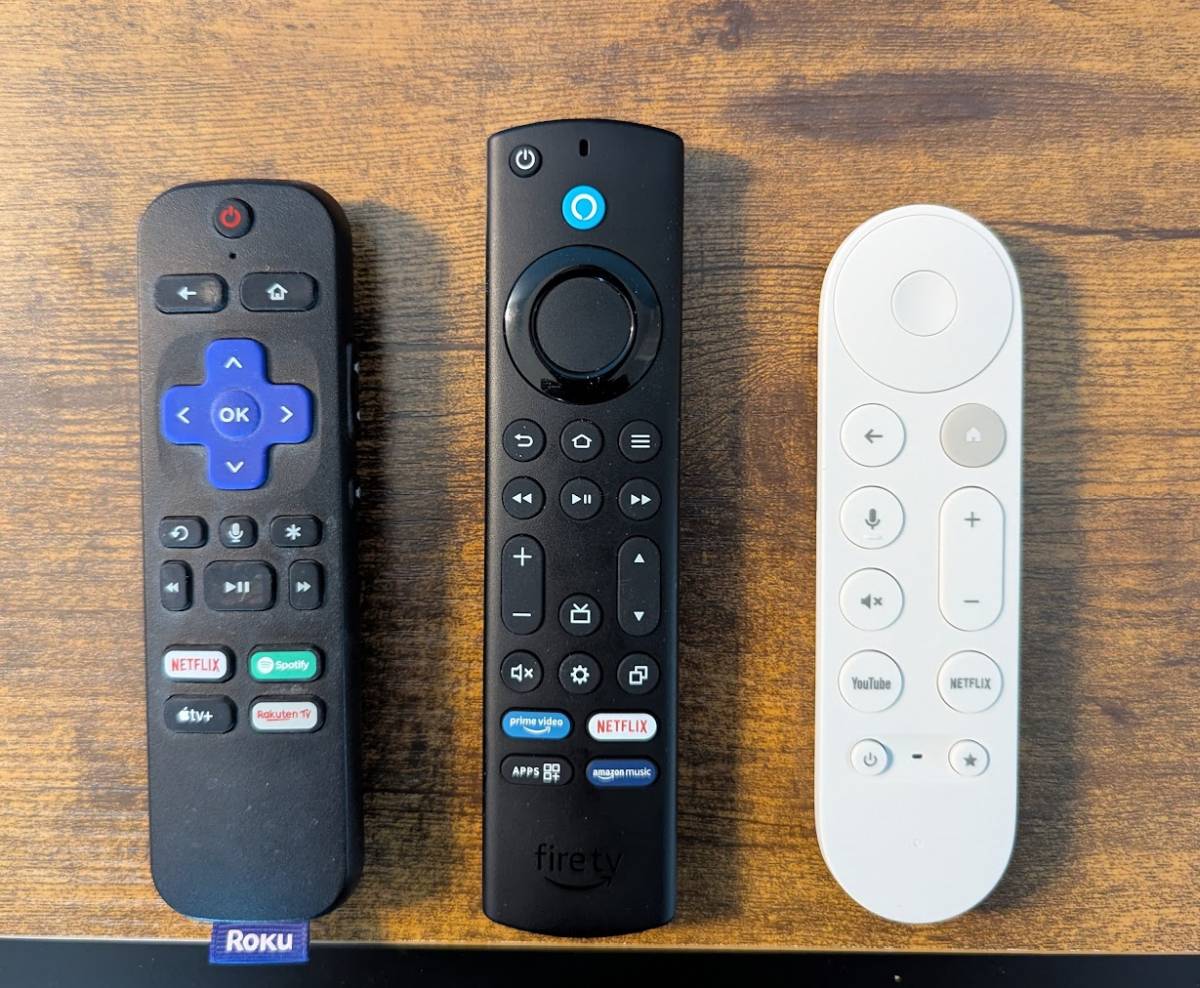
The Amazon Fire TV 4K Max and Roku Stick 4K remotes are pretty similar. They both have ‘movement’ buttons on the top (it’s wheel-shaped on the Firestick), as well as Play/Pause buttons and Fast-Forward and rewind.
The new Google TV Streamer remote is a bit different. For one, it’s smaller – and it also doesn’t have Play/Pause buttons – instead, it relies on the middle “selection” button for those actions.
All three remotes (in these specific models) also have Volume Control buttons (they’re on the side of the remote on the Roku – which is brilliant), a mute button, and a button to turn your TV on/off.
And, all three remotes are also ‘Voice remotes’ – so once you push the Voice button, you can speak to the remote itself and control the device with your voice (more on that later).
All three remotes have shortcut buttons for apps (which the hardware companies reportedly get paid for). These can’t be easily remapped, so they’re not helpful for everyone. The Google TV Streamer remote gets extra points for only having two – YouTube and Netflix.
Amazon also sells a “Pro” version of its Fire TV remote – with a few additional features like backlighting and a ‘Find my remote’ function. Roku has a Pro remote in the US – but they don’t sell it in the UK, unfortunately.
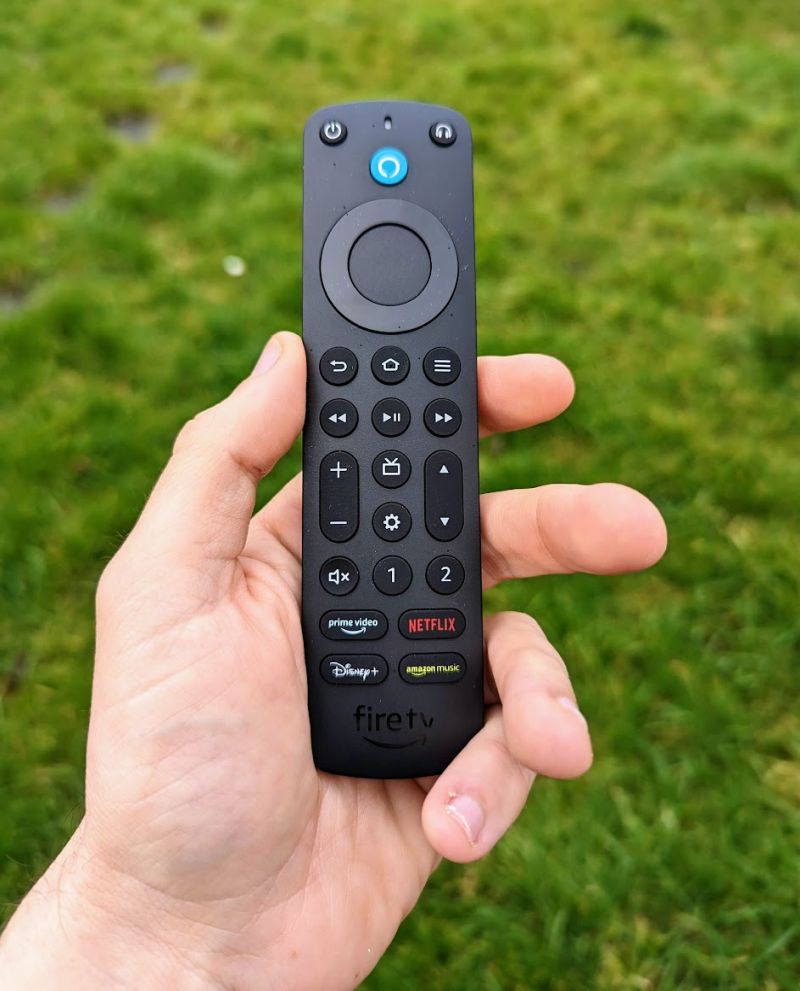
All in all, choosing between the three remotes is a matter of taste above all – but I prefer the button placement on the Roku (Amazon’s Pro remote would have taken first place here – but it costs extra and doesn’t come bundled with any devices).
Remote Controls Winner: Roku Streaming Stick 4K
Voice Control
With voice assistants like Amazon’s Alexa becoming more and more common, both on our phones and in our living rooms, it makes sense that TV streaming devices will also add voice commands.
Amazon’s Fire TV, as expected, has Alexa built into its Voice Remote. It’s not as ‘powerful’ as the Alexa that lives inside Amazon’s Echo devices – but it comes close. Plus, you can’t just start talking – you need to first press the ‘Voice’ button on the remote, and then the Firestick’s Alexa starts listening.
You can give it video-related commands like “Stop”, “Rewind 30 seconds”, etc. You can tell it to “Run Netflix”, or you can search by saying things like “Show me movies with Tom Cruise “, or “Play The Expanse on Prime Video”.
As an Alexa device, you can also ask for the weather (which will then be spoken, as well as shown on your TV screen), or ask a bunch of trivia questions like “How Old Is Keir Starmer?”.
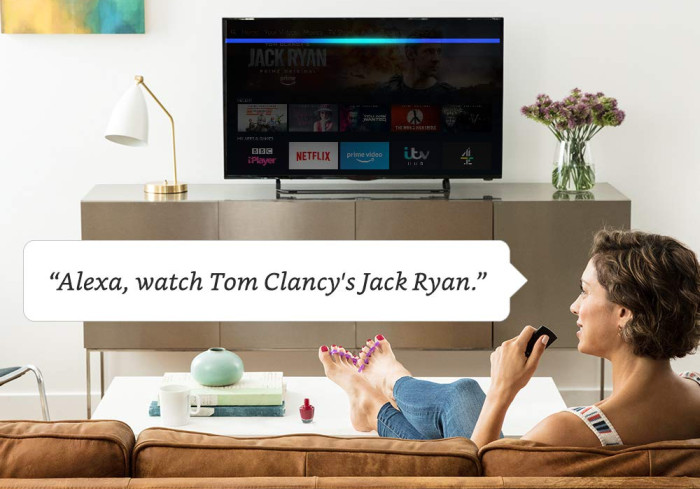
And, if you have an Amazon Echo device, you can pair that as well with your Firestick, and then you don’t even need the remote – you can just say “Alexa”, and give your Echo commands that control your Firestick.
Amazon gets an extra point for its “Ambient Experience” on the 4K Max 2nd Gen sticks – which turns the Fire TV (and your TV) into a “smart display” with on-screen reminders, notifications, the weather, etc.
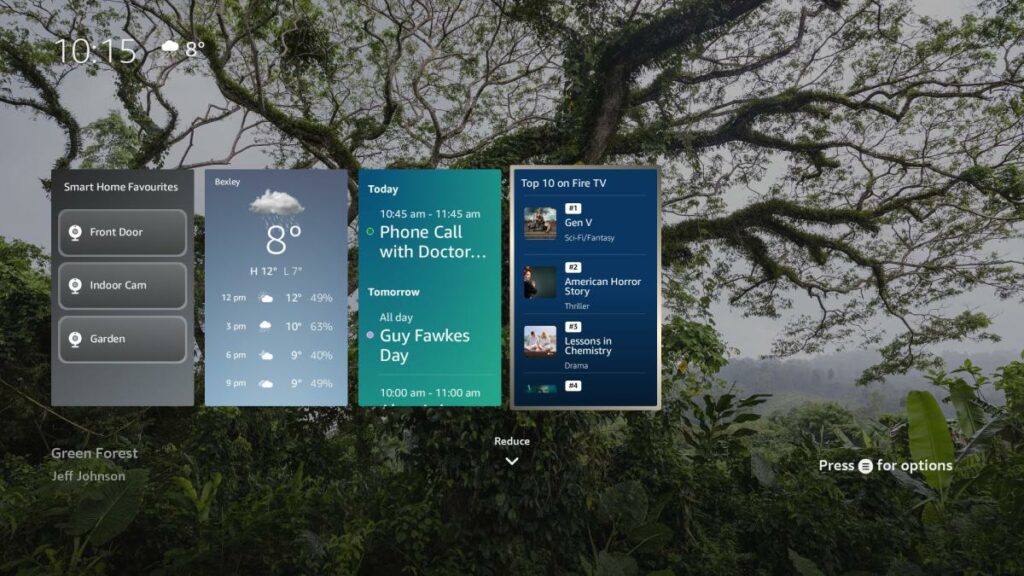
The Roku Streaming Stick 4K also has a Voice-control button on its remote, but it’s a bit more limited, because it doesn’t have the power of Alexa behind it.
So you can give it basic video-playing commands, AND you can search things like “Show me comedies with Steve Martin” – but you don’t get the general questions and information gathering that Alexa has.
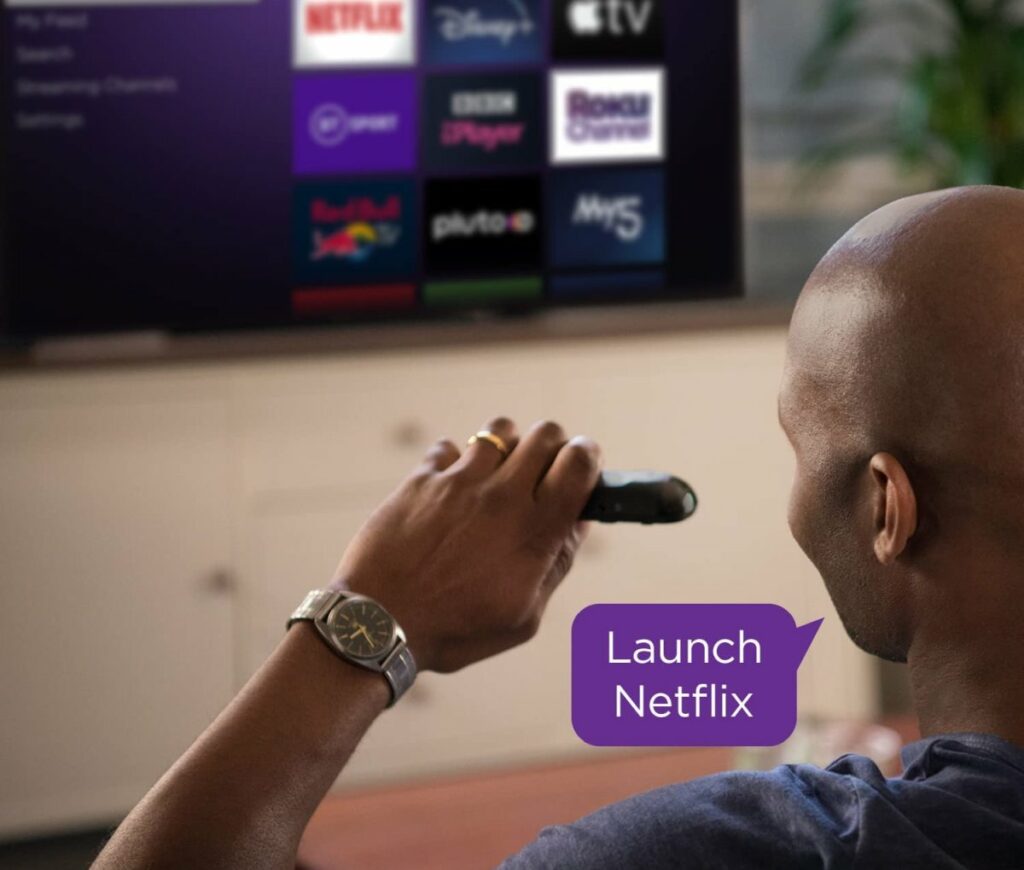
And lastly, the Google TV Streamer has a dedicated Google Assistant button, which can control the TV, search for programmes and apps, or ask general questions (much like the Alexa button).
Choosing between the Google TV Streamer’s assistant and Amazon’s Alexa is often a matter of taste, and depends on the ecosystem in your house (or, I should say, the EchoSystem…) – but for me, with all of its problems (and there are quite a few) – Alexa still takes the lead.
Voice Control Winner: Amazon Fire TV 4K Max Stick
Smartphone App
Although these streaming devices are meant to operate on your telly, they all have accompanying smartphone apps.
The Roku smartphone app wins this category without a doubt. Amazon’s Fire TV app is mainly used as a remote control (if you lose the physical one, for example), and as a handy keyboard when you need to type something on the screen.
The Roku app can also be used as a remote control, but it has several additional nifty features – it has a full-featured content search engine (like the one on the Roku streamer), and you can use the Voice Search on it as well.
However, the best Roku app feature is the ‘Private Listening’ mode. Once the app is paired with your Roku stick, you can plug headphones into your PHONE, tap Private Listening, and anything you’re watching on your TV, will have its sound streamed to your headphones, instead of to the TV’s regular speakers. This is very useful when you’re watching TV late at night, for example.
And the Google TV Streamer? Weirdly, despite this being a device that can be controlled with your smartphone, it doesn’t have its own app.
Instead, you set up the device with the Google Home app, which is used with all of Google’s Home devices – and is notoriously bad.
It’s OK for the initial setup if everything goes smoothly – but if anything goes wrong (and it often does, who knows why), then the app becomes very un-user-friendly, and you have to keep restarting it and having fights with it (if I sound bitter – it’s because I had to do this multiple times, with multiple Google Home devices…)
Smartphone App Winner: Roku Streaming Stick 4K
Streaming Devices – Honourable Mentions
Before we get to the overall best, I wanted to give two unique devices a mention:
Amazon Fire TV Cube 3rd Gen: This is Amazon’s top-of-the-line 4K streaming device, which combines a Fire TV streamer with Echo/Alexa voice control and built-in microphones and a speaker.
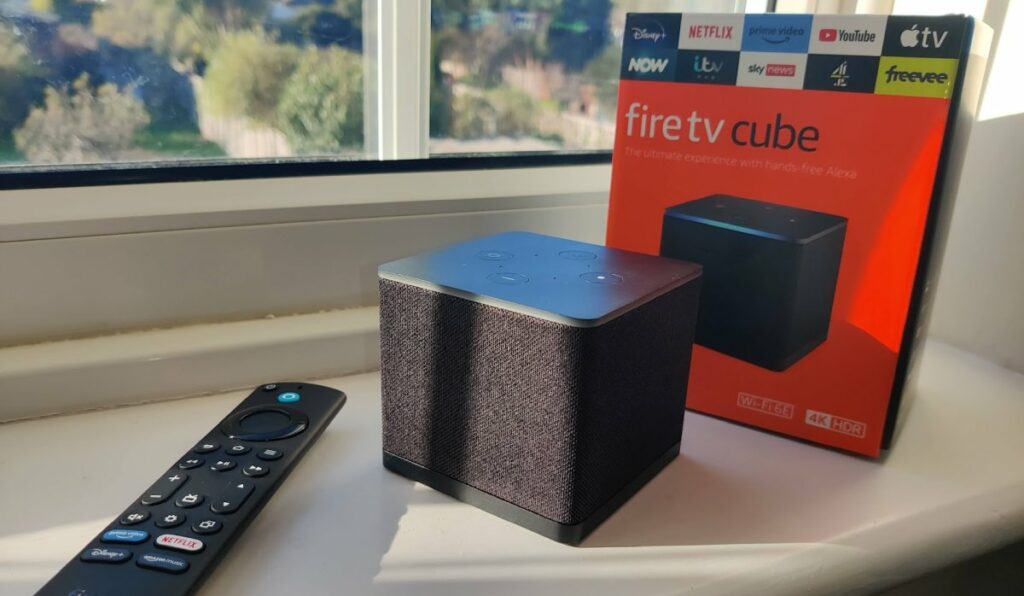
The 3rd generation Cube has an Octa-core processor, so it’s even faster and more powerful than the 4K Max 2nd Gen, and you can use it as a full Alexa voice assistant device without needing the remote control at all.
I’m a big fan of the Fire TV Cube, and you can read my full review of it here. The problem? It costs a lot more than the Fire TV sticks, so it’s harder to recommend – unless you’re also in the market for a small Echo device.
Sky Glass: Sky’s 4K TV set was first announced in October 2021. It features a QLED HDR screen, and a built-in Dolby Atmos soundbar with integrated speakers. And in 2025, Sky finally launched the Sky Glass Gen 2.
Why am I mentioning it here? Because, unlike Sky’s traditional services in the UK, Sky Glass doesn’t use a satellite dish – instead, it relies on broadband, and streams all the content to the TV, so it’s basically a streaming device (with Sky’s channels) baked into a TV.
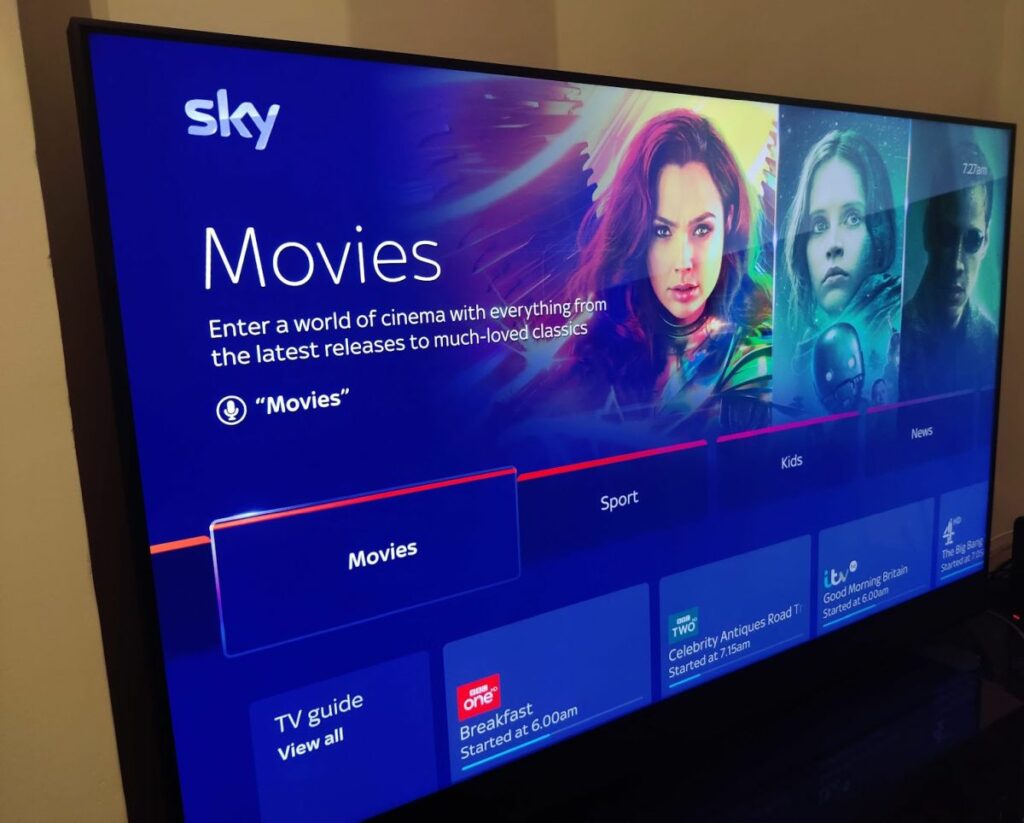
It has a unique interface (though certainly not perfect), a very useful and responsive global search, and it also brings Freeview into the streaming ecosystem.
Of course, it’s a TV, and it costs like a TV, so you can’t compare it to streaming sticks. But it was an interesting first step for Sky into the streaming hardware world (in the UK, at least – and if you don’t consider NOW a full Sky service, which I don’t).
Sky Stream / Virgin Media Stream: In 2022, Sky and Virgin Media both released standalone streaming boxes, that finally let customers sign up to their respective TV services without needing a satellite dish a long-term TV contract.
The two are similar in many ways (see my Sky Stream VS Virgin Media stream comparison), and they also serve as streaming devices, with many 3rd party streaming apps like Netflix, Disney+, BBC iPlayer and many others.
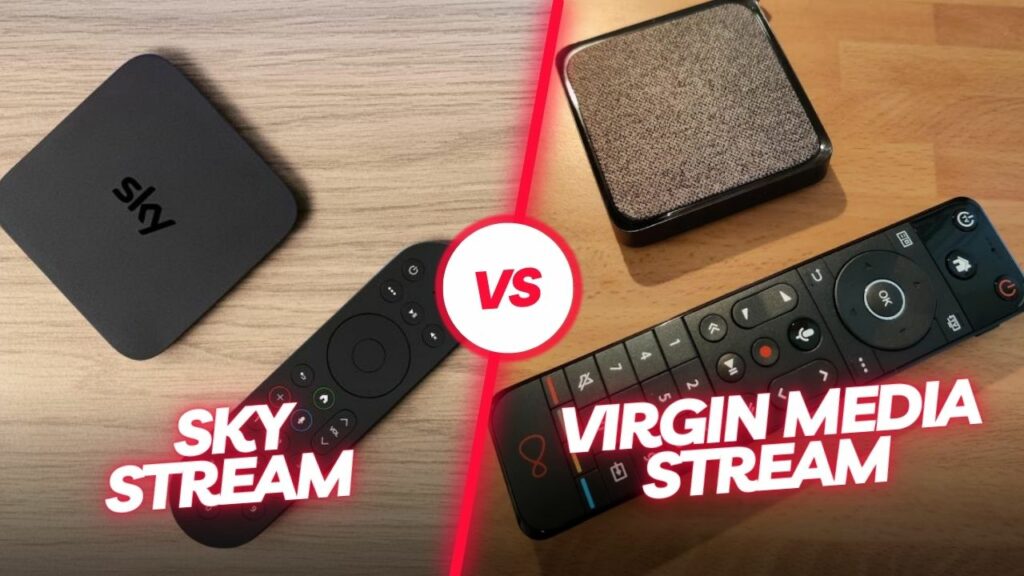
Sky Stream’s main advantage over Virgin Media’s Stream is that you can use it with any broadband provider, therefore it truly is a standalone device. Virgin Media Stream only works if you’re a Virgin Media Broadband customer.
I have to say, with Sky Stream being all grown up now, it’s an excellent streaming device, with a friendly (but powerful and flexible) interface that really puts content curation and selection front and centre.
That being said – it’s not a fully-featured streaming device (as it only supports a limited selection of apps that Sky approves), and you can only get it along with an ongoing Sky subscription.
However, if you’re interested in subscribing to Sky (or Virgin Media’s broadband) – these are certainly devices to consider.
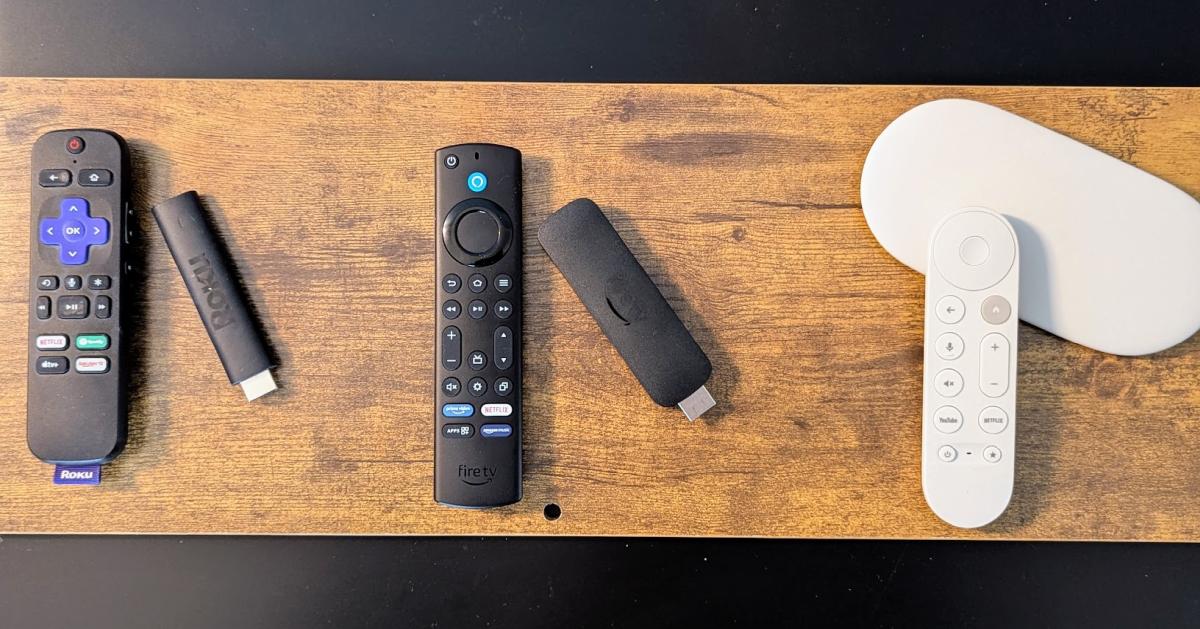
Best Overall Streaming Device: The Fire TV 4K Max (2nd Gen)
Yes, after 5 years of Roku being on top – the Fire TV 4K Max stick is taking the lead in 2025.
If offers the best combination of hardware and performance (with a slick and snappy interface), a huge selections of streaming apps and is relatively easy to use (more so for streaming experts than streaming beginners, though).
The interface is still too messy at times (not to mention all the adverts and banners scattered around), and it sometimes feels like it has too many features and options for its own good – but the plus side to that is all the flexibility you get to tailor the Fire TV experience to your liking.
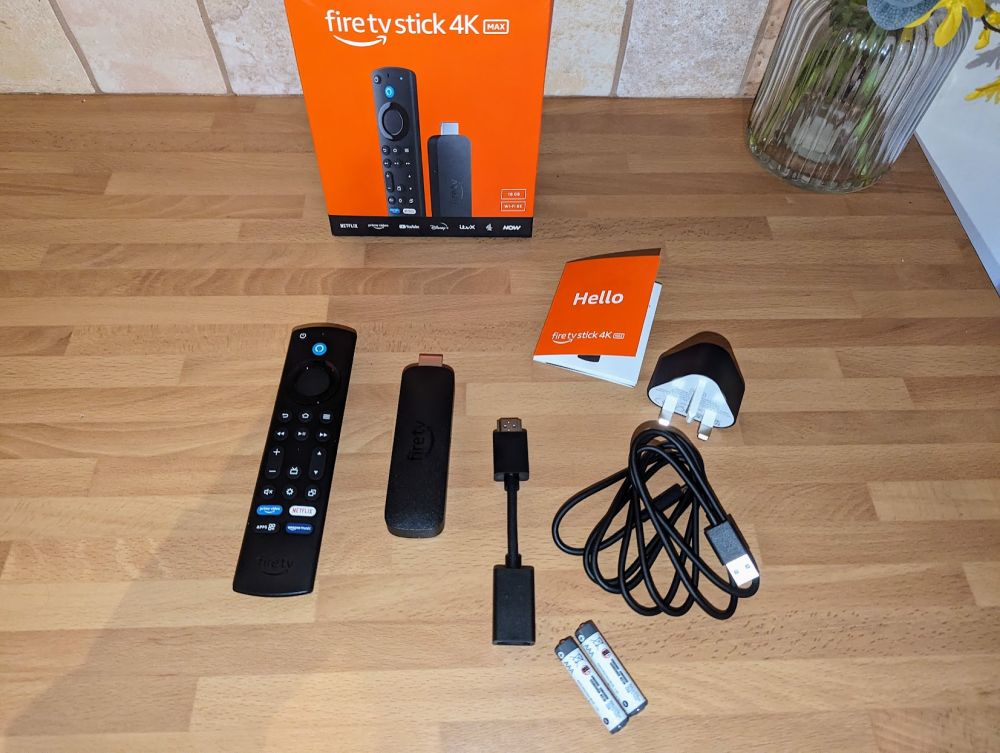
As for Roku – don’t get me wrong – the Roku Streaming Stick 4K still provides a great combination of features, performance, and price, and it’s a joy to use, especially for beginners (yes, your grandparents too), with a vast selection of streaming services and apps.
However, it’s beginning to feel like Roku has almost given up on the UK streaming stick market (unlike the Roku TV market, where they keep releasing new TVs with Roku built-in, from various manufacturers). The new Roku Ultra streamer, for example, was never in the UK – and neither did the Roku Pro remote.
So, the Roku Streaming Stick 4K feels a bit dated at this point – both in terms of the hardware, and the operating system.
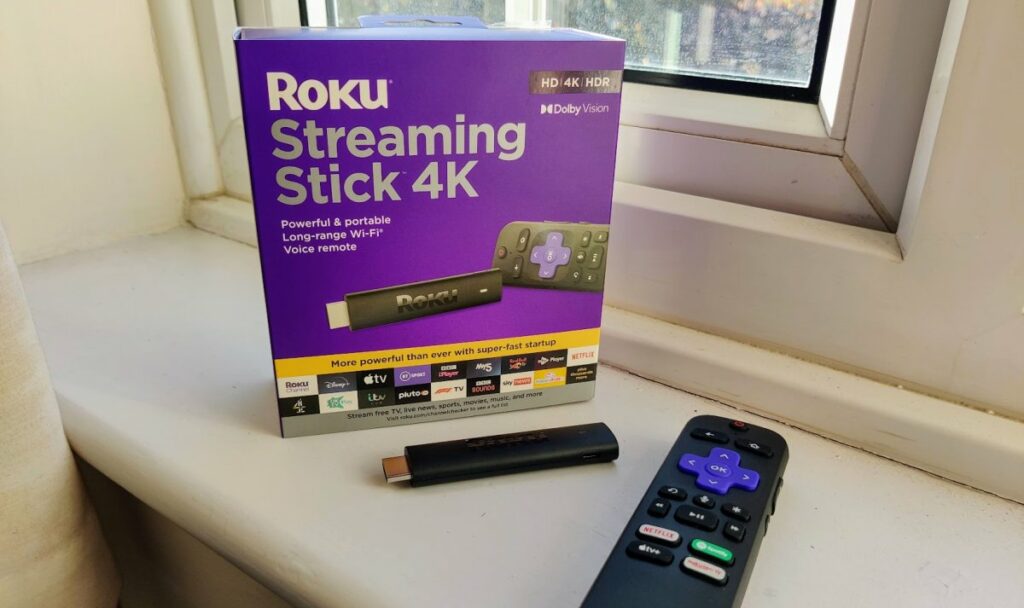
In third place, still, is the Google TV Streamer. It’s an excellent device, and the interface shows a lot of promise (especially in how it brings together your ‘Continue Watching’ lists from various services) – but its huge price increase (over the previous model) and the more limited availability of apps, puts it behind.
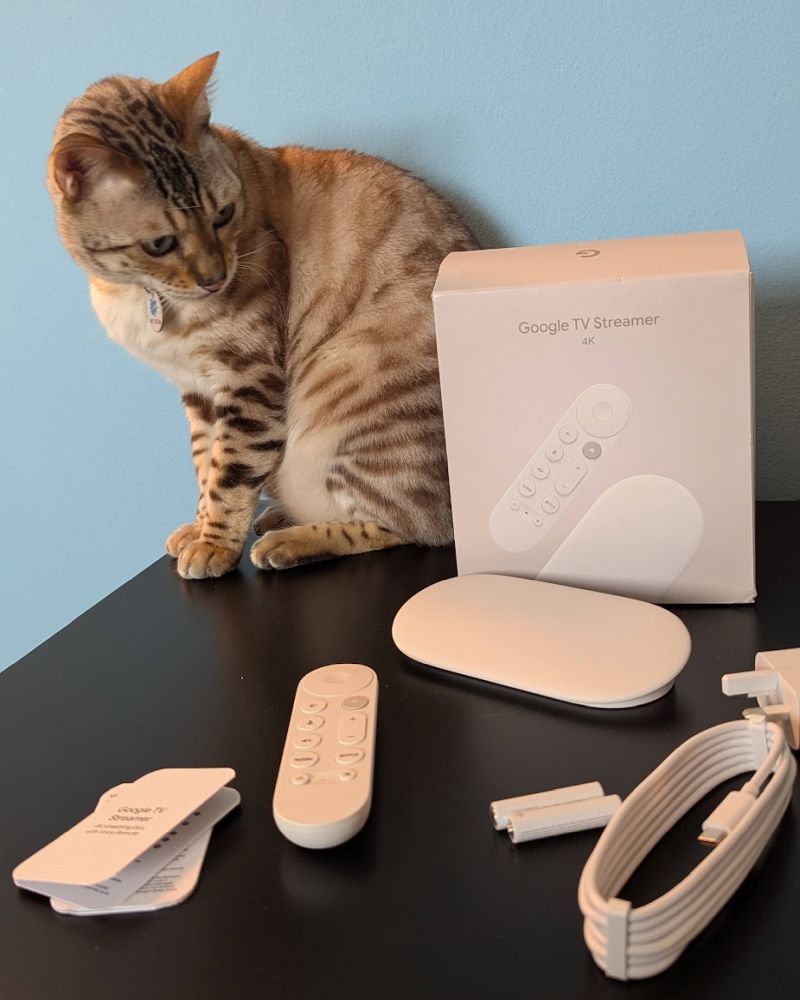
For even more information on each of the streaming devices, you can read my full review of the Roku Streaming Stick 4K, and my Amazon Fire TV 4K Max 2nd Gen Stick review.
You can find the Fire TV 4K Max (2nd Gen) on Amazon and Currys.
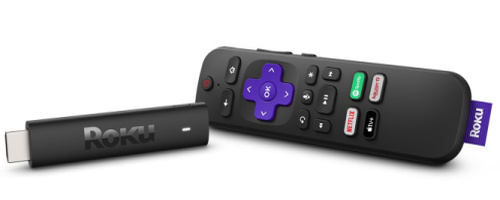
Is it possible to download Freeview to Firestick Lite ?
I stopped reading after “Apple TV does not add extra value” You must be kidding…
I’ve read and enjoyed your content for some time, some great advice for anyone looking to “cut the cord”. I do however think that you ignore / dismiss the Apple TV 4K option too readily and have done for a while. It’s a superb streaming device – I’ve tried many of them including Roku and Firestick and the speed, quality and UX of the Apple TV wins. Appreciate that everyone has a valid opinion / preference. It’s not expensive when used to stream everything instead of paying for subscriptions, which is surely the whole point?
Is the NOW app compatible with Google Streamer like it was with Chromecast with Google TV?
Just ordered the Roku 4K Stick from Argos. I guess I’m lucky they had in my area.
My understanding is that you need to cast Prime to the Chromecast. Is this a misprint?
That’s on the old Chromecasts (the ones without the remote), where you had to cast everything. The new ones, with Google TV, have a Prime Video app
Ignoring price for now, would you opt for the Fire TV Cube over any of these sticks?
I’m a big fan of the Fire TV Cube. However – I think it only makes sense if you intend to use the Echo/Voice Assistant features. Otherwise, you might as well go for the 4K Max (2nd Gen) Stick, which is just as powerful (well, almost), and even has a newer OS version
The Roku streaming stick seems to be out of stock everywhere. I need a stick for my older Panasonic Smart TV as I have lost the ITV app and my even older Humax box can’t get ITVX either. The TV is the Panasonic Viera TX40DX700B. What would be best for this TV, please? I like everything to be as simple to use as possible!
PS This TV connects via ethernet and does not have wifi. I use devolo plugs via my electricity wiring to get the connection to my broadband hub. This works very well. I may get a replacement for the Humax box this year.
I’m seeing stock of the Roku Streaming Stick 4K on Argos and Currys (but it depends on your postcode with them…)
When did the Chromecast with Google TV get an All 4 app? I thought it wasn’t available on Android TV/Google TV?
You’re correct, there’s no All4 app for Google TV, though you can sort of cast it via the Chromecast platform. I changed the wording on the table to make it clearer
The trouble is;
You cannot simple dismiss Apple TV just as being more expensive and offering little more.
I have over time, used all the devices(except the dedicated Sky and VM boxes.) and AppleTV beats them hands down for speed and quality.
I have to agree, yes the AppleTV box is a premium product however its features outstrip all the other streamers on the market. Simply put the picture and sound quality alone make it an amazing buy. Beyond that, if you have Sky you can install SkyGo and use it as a mini-box. If you have EE broadband you can sign into their TV service within the settings, I have a hunch we may see Freely become an option further down the line. The integration of what you are watching from other services and, within the AppleTV app on the box it even has a menu to specifically show you what is popular on your services (Netflix being the exception for now). This gives you a much clearer view than everything being on the Home Screen. Of course there are, if you have other apple products, a myriad of other options such as Fitness that links with your iPhone or watch to accurately monitor your workout. Having spent many years being sort of happy with all the others this proves there is a streamer out there that where the only fault I can pick with it, is the fact Netflix won’t play ball and allow their content to be shown within the aggregation on the AppleTV app, something totally out of Apple’s control. It would be nice to see you do a new review including the AppleTV as it’s had a lot of software updates that put it even further ahead.
No subtitles on the BBC iPLayer app either, this really p**ses me off
NVidia Shield TV should at least have an honourable mention here as well, all streaming services and the added advantage of being able to host a Plex Server for all those who have their own content on NAS. More powerful than any of the aforementioned devices, a better interface (IMHO). I don’t personally use it for gaming or game streaming if you have a powerful PC.
Are any of these able to give AD as my wife is almost blind
If you’re referring to the menus of the device, then all of them have optional versions of “talking” menus. If you’re talking about the content – they all support it, but whether AD exists or not (for what you’re watching) depends on the specific channel/streaming service you’re using.
I’m a sucker for the Amazon firestick. Once i’m set in my ways with a certain inferface or programme I rarely deviate to anything else.
You may have twisted my arm ever so slightly to check out the Roku thou!
I was the same way, and I’ve had various versions of the Fire TV since 2014 or so. And even though I still like it – for the past few months I’ve been doing most of my streaming on the Roku stick. It just “feels” quicker and more streamlined
You say “All three devices connect to the internet via WiFi (The Roku stick also has a built-in WiFi booster that increases the range), and all three also have optional Ethernet adaptors, if your WiFi reception is problematic.”
Roku does not seem to have an Ethernet adaptor available.
There are 3rd party adapters that claim to work with the Roku stick, plus some have had success using the Chromecast adapter with the Roku – but frankly, I wouldn’t even bother to try. If you need an Ethernet streamer, the Fire TV stick (with its official adapter) would probably be best.